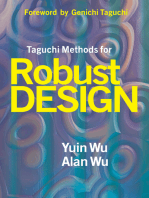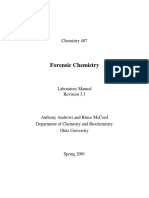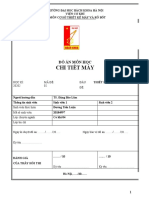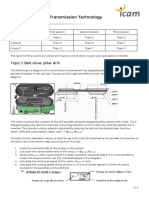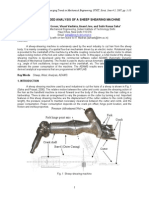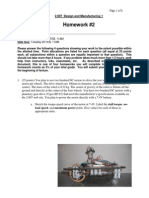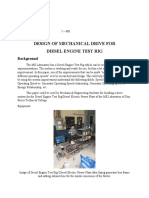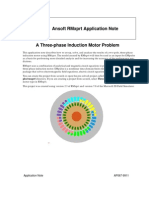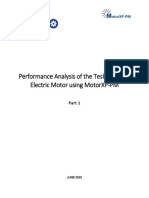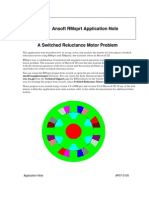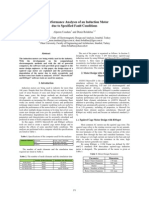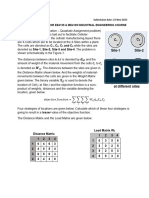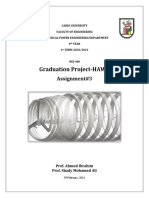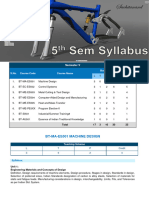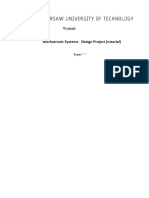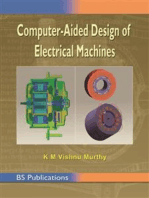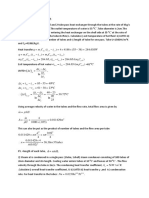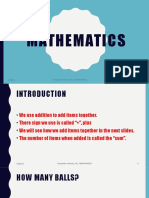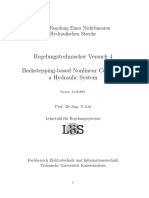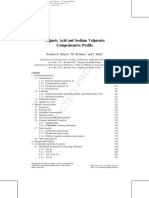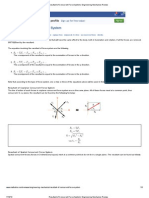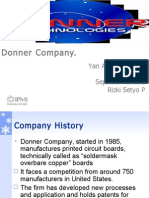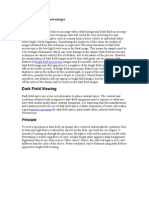Belt Drive Handout - 05
Belt Drive Handout - 05
Uploaded by
NkoshiEpaphrasShoopalaCopyright:
Available Formats
Belt Drive Handout - 05
Belt Drive Handout - 05
Uploaded by
NkoshiEpaphrasShoopalaOriginal Title
Copyright
Available Formats
Share this document
Did you find this document useful?
Is this content inappropriate?
Copyright:
Available Formats
Belt Drive Handout - 05
Belt Drive Handout - 05
Uploaded by
NkoshiEpaphrasShoopalaCopyright:
Available Formats
ME 302 -MACHINE DESIGN II
SEMESTER 6
DESIGN OF A BELT DRIVE SYSTEM
Problem:
A belt drive system is to be designed for a Power Transmission System used in a small
workshop. According to the lay-out given below, two lathe machines are driven by an electric
motor via an overhead line shaft. Power is transmitted from the motor to the line shaft by a V-
belt drive and from the line shaft to the machines by independent flat back drives.
3m
Fig 1- Belt drive system
Data:
1. Line shaft is 2.0 m. above the centre line on the Motor and Machine shafts.
2. Speed ratio of Motor/Line shaft is N1
3. Speed ratios of Machine/Line shaft are N21 and N22
4. Power of Machines are X1 and X2 kW
5. Losses through the transmission,
Bearing efficiency factor =0.99
Efficiency factor of V-belt drive =0.98
Efficiency factor of Flat-belt drive =0.95
6. Type of electric motor, 4- pole induction motor
How to obtain individual data:
1. Speed ratio of Motor/Line Shaft N1
Divide student se. number by 3, if the remainder =0 then N1 = 1.5
=1 = 2.0
=2 = 2.5
2. Speed ratio of Machine/Line Shaft N21, N22
2.1. Machine No. 1 N21 = 2.0 for all ODD student se. number
= 2.5 for all EVEN student se. number
2.2. Machine No. 2 N22
Divide student se. number by 4, if the remainder = 0 then N22 = 1.5
=1 = 2.0
=2 = 2.5
=3 = 3.0
3. Power of Machine X1 and X2
Divide student se. numbers by 6,
If the remainder = 0 then, X1= 4.0 kW, X2= 3.5 kW
=1 = 4.5 kW = 4.0 kW
=2 = 5.0 kW = 4.5 kW
=3 = 5.5 kW = 5.0 kW
=4 = 6.0 kW = 5.5 kW
=5 = 6.5 kW = 4.0 kW
Example; Let student se. number 54
1. Speed ratio Motor/Line Shaft N1
54/3 remainder= 0 then, N1 = 1.5
2. Speed ratios Machine Shaft/Line Shaft
54 is an EVEN number, then N21 = 2.5
54/4 remainder = 2 then, and N22 = 2.5
3. Power of Machines
54/6 remainder = 0 then X1 = 4.0 kW and X2 = 3.5 kW
Time Duration: 6 Sessions (4 Calculations and 2 Drawing sessions)
Format of the Design Drawing
Drawing Sheet : Size A2
Time Duration: Two drawing sessions
1. Representation of all the details with one, two or three main views.
2. Part drawings for each and every component.
3. Assembly or sub assembly drawing as necessary.
4. A sketch of application set up.
5. Tables for;
Selected and design components as necessary, Problem data, Material data,
System specifications, Machining or manufacturing details etc.
Format of the Design Report
(Sections to be included)
1. Date
2. Title
3. Problem
4. Introduction
5. Notation
6. Data
Problem data, Material selection data, Design data
7. Design Calculations
Where ever possible please provide sketches, figures as necessary to illustrate various
parameters used in your calculation
7.1. Power, Torque calculations using given data and considering losses through the
transmission
7.2. Selection of motor using given standard catalogues
7.3. Design of V-belt drive (one drive)
7.4. Centre distance, speed ratios, Pulley diameters, length of belts, standard nominal length,
selection of belt section type, number of belts required, and check for service level.
7.5. Design of Pulleys for the V-belt drive (two pulleys).
Face width of pulleys, outer diameter, size of the boss, width of the hub, number
of arms and cross section, check for the failure in arms (bending shear), check for
failure in rim (critical speed etc.)
7.6. Design of Flat Belt Drives (two drives)
Centre distance, speed ratios, Pulley diameters, and length of belts, length
correction, selection of belts and belt materials, size of the belt (cross section), check
for belt tension, and selection of face width of the pulley.
7.7. Design of Pulleys for Flat Belt Drives.
Face width, Pulley dimensions, size of the boss, width of the hub, number of arms
and cross section, checks for failure in arms (shear, bending) checks for failure in rim
(critical speed etc.)
7.8. Design of the line shaft
Diameter of line shaft, Estimation of masses of pulleys on the line shaft, power
through each drive, Belt tensions, Torque at each pulley, Torque diagram, Force
diagram through each drive, Force due to self weight of pulley and belt tension,
Components in horizontal and vertical directions, Bending moment diagram for vertical
and horizontal directions, Maximum bending moment and resultant maximum bending
moment, Maximum combined stresses(torsion and bending), Check for the diameter of
the shaft.
7.9. Design of key and key ways
Keys for motor shaft, Line shat and machine shafts. Key section, Type, Cross
section and length, Check for failures
7. Results
Results in tabulated form, List of components, System specifications, Material
and Manufacturing details of components.
Mech/E05/Jan/2009
You might also like
- Lab Report Experiment TrussesDocument14 pagesLab Report Experiment TrussesNEWTAN100% (3)
- Machine Design Elements and AssembliesFrom EverandMachine Design Elements and AssembliesRating: 3.5 out of 5 stars3.5/5 (2)
- Mathematical Puzzles and PastimesDocument253 pagesMathematical Puzzles and PastimesMihajlovic Dragan100% (19)
- Magnetic Analysis of A Solenoid ActuatorDocument11 pagesMagnetic Analysis of A Solenoid ActuatorAanchal SrivastavaNo ratings yet
- Schaum S Outlines-MatrixOperations PDFDocument235 pagesSchaum S Outlines-MatrixOperations PDFNkoshiEpaphrasShoopala100% (1)
- Stable GlazesDocument8 pagesStable Glazesdamjan_mariničNo ratings yet
- Forensic Chemistry - Laboratory Manual ANDREWS 2001 PDFDocument75 pagesForensic Chemistry - Laboratory Manual ANDREWS 2001 PDFjavier chavezNo ratings yet
- Nitric AcidDocument50 pagesNitric AcidUsman Hameed100% (3)
- DTSDocument7 pagesDTSmithundme659No ratings yet
- Duong Tien Luan - 20184997 - 124427Document18 pagesDuong Tien Luan - 20184997 - 124427Tien LuanNo ratings yet
- Machine Design Mini Project, Sem I 2018 2019Document2 pagesMachine Design Mini Project, Sem I 2018 2019lucasNo ratings yet
- Project For Gearbox DesignDocument3 pagesProject For Gearbox DesignChandra SekarNo ratings yet
- Application of GA Took For Design Optimization of Squirrel Cage Induction MotorDocument14 pagesApplication of GA Took For Design Optimization of Squirrel Cage Induction Motordarshil modiNo ratings yet
- Assignment No 1 (ME 461)Document6 pagesAssignment No 1 (ME 461)Jayant Raj SauravNo ratings yet
- Calculation Report FinalDocument62 pagesCalculation Report FinalJethro JeyarajNo ratings yet
- EIR 221 Prac 3 Guide 2017Document5 pagesEIR 221 Prac 3 Guide 2017mpaka felliNo ratings yet
- MatDyn1 2Document35 pagesMatDyn1 2Miguel AcbNo ratings yet
- Practical Work Power Transmission - QuitoDocument4 pagesPractical Work Power Transmission - Quitoalejangruerrero04No ratings yet
- Power Transmission Elements-V-Belts LINKSDocument6 pagesPower Transmission Elements-V-Belts LINKSaz7303782No ratings yet
- Computer Aided Analysis of A Sheep Shearing MachineDocument10 pagesComputer Aided Analysis of A Sheep Shearing MachineHarsh SharmaNo ratings yet
- Servo Motor Design Using MotorSolveDocument20 pagesServo Motor Design Using MotorSolveSK PNo ratings yet
- WEEK04Document27 pagesWEEK04Khang NhậtNo ratings yet
- Yu Xiangs Sugar Cane Machine ReportDocument53 pagesYu Xiangs Sugar Cane Machine ReportadstrativeclownNo ratings yet
- IM Electromagnetic ModelDocument44 pagesIM Electromagnetic ModelThiago SchmoellerNo ratings yet
- Homework #2: 2.007 Design and Manufacturing 1Document8 pagesHomework #2: 2.007 Design and Manufacturing 1elvagojpNo ratings yet
- Ricardo WAVE REPORTDocument7 pagesRicardo WAVE REPORTZohaib AliNo ratings yet
- Small Wind Turbine DesignDocument19 pagesSmall Wind Turbine DesignIqbal MeskinzadaNo ratings yet
- Technical Analysis of BakerDocument27 pagesTechnical Analysis of BakerManu KhodNo ratings yet
- HES3350 Machine Design Semester 1 2012 Assignment 1 Compound Reverted Gear Train Design PDFDocument18 pagesHES3350 Machine Design Semester 1 2012 Assignment 1 Compound Reverted Gear Train Design PDFrisirarocksNo ratings yet
- CAD.manual.Document15 pagesCAD.manual.manojofficial1107No ratings yet
- ME365 Fall 2014 Project-2Document3 pagesME365 Fall 2014 Project-2Wijaya Budi SantosoNo ratings yet
- What Are The Storage Devices in CAD?Document23 pagesWhat Are The Storage Devices in CAD?shunmugeshNo ratings yet
- Eee Vi Electrical Machine Design (10ee63) NotesDocument206 pagesEee Vi Electrical Machine Design (10ee63) NotesEdwin Santiago Villegas Auques100% (1)
- Design of Mechanical Drive For Diesel Engine Test Rig: BackgroundDocument10 pagesDesign of Mechanical Drive For Diesel Engine Test Rig: BackgroundAyuguNo ratings yet
- A Three-Phase Induction Motor ProblemDocument26 pagesA Three-Phase Induction Motor ProblemmehmetNo ratings yet
- A Three-Phase Induction Motor ProblemDocument26 pagesA Three-Phase Induction Motor Problemowen674s100% (2)
- Module2 ProblemSet 10302023Document7 pagesModule2 ProblemSet 10302023Mahesh vangaraNo ratings yet
- Theoretical Analysis of Multi Way PowerDocument4 pagesTheoretical Analysis of Multi Way PowerTanjid Al TajimNo ratings yet
- Design and Static Analysis of Gearbox For A CNCDocument9 pagesDesign and Static Analysis of Gearbox For A CNCأحمد دعبسNo ratings yet
- Performance Analysis of The Tesla Model 3Document12 pagesPerformance Analysis of The Tesla Model 3Name24122021No ratings yet
- 9105 - Automobile Component DesignDocument5 pages9105 - Automobile Component DesignOnkar Sawant100% (1)
- Eee3005 Design-Of-electrical-Apparatus Eth 1.0 37 Eee3005Document2 pagesEee3005 Design-Of-electrical-Apparatus Eth 1.0 37 Eee3005Amal AnilNo ratings yet
- 开关磁阻电机的ANSOFT建模方法Document28 pages开关磁阻电机的ANSOFT建模方法Nuwantha FernandoNo ratings yet
- The Performance Analyses of An Induction Motor Due To Specified Fault ConditionsDocument5 pagesThe Performance Analyses of An Induction Motor Due To Specified Fault ConditionsyugendraraoknNo ratings yet
- Case Study 01 - Part 1 + 2Document19 pagesCase Study 01 - Part 1 + 2quang.nguyenken123No ratings yet
- EEE3005 Design of Electrical ApparatusDocument2 pagesEEE3005 Design of Electrical ApparatusStella GrantNo ratings yet
- Analysis of Windscreen Wiper Mechanism Using MSC AdamsDocument15 pagesAnalysis of Windscreen Wiper Mechanism Using MSC AdamsDeepak SomanNo ratings yet
- Huong Dan Lam Do An 11Document10 pagesHuong Dan Lam Do An 11Võ Thiện NhânNo ratings yet
- Foreword Preface About The Authors: Admin Aug 14th, 2021 0 CommentDocument101 pagesForeword Preface About The Authors: Admin Aug 14th, 2021 0 Commentlvb123No ratings yet
- Assignment-I 23oct23Document10 pagesAssignment-I 23oct23Lingala JayapradaNo ratings yet
- U 02530863088Document3 pagesU 02530863088TobiasOliveiraNo ratings yet
- MEC 305 Machine Design Lab GEAR PDFDocument57 pagesMEC 305 Machine Design Lab GEAR PDFanmol 898No ratings yet
- Unit Wise Theory and Numerical Question BankDocument14 pagesUnit Wise Theory and Numerical Question BankVinayak GonelNo ratings yet
- Assignment#3Document10 pagesAssignment#3Mohamed MedhatNo ratings yet
- Selection of Optimal Slice Count For Multi-Slice Analysis of Skewed Induction MotorsDocument5 pagesSelection of Optimal Slice Count For Multi-Slice Analysis of Skewed Induction MotorsSharan ShastriNo ratings yet
- 4.1. Magnetic Analysis of A Solenoid Actuator: 4.1.1. Problem SpecificationDocument9 pages4.1. Magnetic Analysis of A Solenoid Actuator: 4.1.1. Problem SpecificationRickson Viahul Rayan CNo ratings yet
- 5th Sem Syllabus DseuDocument8 pages5th Sem Syllabus DseuSachin KumarNo ratings yet
- Design and Analysis of Lead Screw For FixtureDocument7 pagesDesign and Analysis of Lead Screw For FixtureA PPNo ratings yet
- Machine Tool Design PDFDocument4 pagesMachine Tool Design PDFrishitNo ratings yet
- final_Technical DocumentationDocument10 pagesfinal_Technical DocumentationvimalrajnagappanNo ratings yet
- Design and Analysis of Crankshaft For Single Cylinder 4-Stroke Deisel EngineDocument3 pagesDesign and Analysis of Crankshaft For Single Cylinder 4-Stroke Deisel EngineChetan GuptaNo ratings yet
- Economic and Financial Modelling with EViews: A Guide for Students and ProfessionalsFrom EverandEconomic and Financial Modelling with EViews: A Guide for Students and ProfessionalsNo ratings yet
- Glossary of Sae and Toyota TermsDocument3 pagesGlossary of Sae and Toyota TermsNkoshiEpaphrasShoopalaNo ratings yet
- How To Use This Automatic Transmission Repair Manual: General InformationDocument3 pagesHow To Use This Automatic Transmission Repair Manual: General InformationNkoshiEpaphrasShoopalaNo ratings yet
- 16 Kinetics Rigid BodiesDocument30 pages16 Kinetics Rigid BodiesNkoshiEpaphrasShoopalaNo ratings yet
- Dynamics 13esi Solutions Manual c19 PDFDocument57 pagesDynamics 13esi Solutions Manual c19 PDFNkoshiEpaphrasShoopalaNo ratings yet
- Du Preez WildDocument1 pageDu Preez WildNkoshiEpaphrasShoopalaNo ratings yet
- Problems in Heat ExchangersDocument4 pagesProblems in Heat ExchangersNkoshiEpaphrasShoopalaNo ratings yet
- Speficications: For Swakopmund Municipality at SwakopmundDocument1 pageSpeficications: For Swakopmund Municipality at SwakopmundNkoshiEpaphrasShoopalaNo ratings yet
- Lecture13 StatisticsDocument60 pagesLecture13 StatisticsNkoshiEpaphrasShoopalaNo ratings yet
- Lab AssignmentDocument62 pagesLab AssignmentEmma Amir0% (1)
- Forced ConvectionDocument5 pagesForced ConvectionNkoshiEpaphrasShoopalaNo ratings yet
- Grade 1 PresantationDocument8 pagesGrade 1 PresantationNkoshiEpaphrasShoopalaNo ratings yet
- EGR280 Mechanics 15 MassMomentsDocument11 pagesEGR280 Mechanics 15 MassMomentsNkoshiEpaphrasShoopalaNo ratings yet
- Coefficient of Determination Worksheet AnswersDocument9 pagesCoefficient of Determination Worksheet AnswersNkoshiEpaphrasShoopalaNo ratings yet
- Unit 2 - Internet EmailDocument56 pagesUnit 2 - Internet EmailNkoshiEpaphrasShoopalaNo ratings yet
- 1 Frequency ResponseDocument49 pages1 Frequency ResponseNkoshiEpaphrasShoopalaNo ratings yet
- Partial Differential Equations and Fourier AnalysisDocument195 pagesPartial Differential Equations and Fourier AnalysischakfarmerNo ratings yet
- Short Introduction of Sizing / Warping / WeavingDocument14 pagesShort Introduction of Sizing / Warping / WeavingAmir YasinNo ratings yet
- Barbero Curriculum VitaeDocument23 pagesBarbero Curriculum Vitaemesfin DemiseNo ratings yet
- Backstepping Control Design LabDocument42 pagesBackstepping Control Design LabAin KaloiNo ratings yet
- Maintenance Handbook On Roller Bearing Fitted On WDM2 Diesel Locomotive - English - 2Document58 pagesMaintenance Handbook On Roller Bearing Fitted On WDM2 Diesel Locomotive - English - 2Sourav PaulNo ratings yet
- Acidificación de Matriz.Document52 pagesAcidificación de Matriz.jorollig-1No ratings yet
- Accelerated Algebra 2 Unit 6 Performance Task 2 - Ferris WheelDocument2 pagesAccelerated Algebra 2 Unit 6 Performance Task 2 - Ferris WheelAnthony RelatorNo ratings yet
- Solid MechanicsDocument19 pagesSolid MechanicsManoj Manoharan100% (1)
- FORMATEMANUAL A5 Crystallization TemperatureDocument20 pagesFORMATEMANUAL A5 Crystallization TemperaturejcNo ratings yet
- Karunakaran Book - Science Chemistry Fair Experiments - HighlightsDocument15 pagesKarunakaran Book - Science Chemistry Fair Experiments - HighlightsKarunakaran C100% (1)
- The Use of Barium Sulfate in Printing Inks As Filler MaterialDocument161 pagesThe Use of Barium Sulfate in Printing Inks As Filler MaterialMia ElliläNo ratings yet
- Definition of Uniform Plane Wave An EN Wave Propagating in X-Direction Is Said ToDocument3 pagesDefinition of Uniform Plane Wave An EN Wave Propagating in X-Direction Is Said ToDivya SrijuNo ratings yet
- CFD Notes 2Document36 pagesCFD Notes 2Badal MachchharNo ratings yet
- Acrawax-C PowderDocument1 pageAcrawax-C PowderHelena Gita VaniaNo ratings yet
- Code and Answers-VBKMDocument23 pagesCode and Answers-VBKMashokallu16No ratings yet
- Integration by Partial FractionsDocument6 pagesIntegration by Partial FractionsStashNo ratings yet
- 21Document32 pages21ziadddNo ratings yet
- Timing of Event Through Dasa and TransitDocument8 pagesTiming of Event Through Dasa and TransitSanjay Sinha100% (2)
- Atmospheric MuonsDocument25 pagesAtmospheric MuonsSayan DasNo ratings yet
- University of Delhi: Semester Examination May-June 2019 Statement of MarksDocument2 pagesUniversity of Delhi: Semester Examination May-June 2019 Statement of MarksTamannaNo ratings yet
- Resultant of Concurrent Force System - Engineering Mechanics ReviewDocument2 pagesResultant of Concurrent Force System - Engineering Mechanics Reviewimrancenakk0% (2)
- Fundamentals of NMR - James PDFDocument31 pagesFundamentals of NMR - James PDFSoundarya ChandramouleeswaranNo ratings yet
- Donner Company.: Yan Anantakusumo Yudistiawan Septima Nurlailia Rizki Setyo PDocument12 pagesDonner Company.: Yan Anantakusumo Yudistiawan Septima Nurlailia Rizki Setyo PRizki Setyo PratomoNo ratings yet
- Dark Field Viewing: Advantages and DisadvantagesDocument4 pagesDark Field Viewing: Advantages and Disadvantagesanon-929496100% (1)
- Steady-State Analyses of Fluid Flow Characteristics For AFWS in PWR Using Simplified CFD MethodsDocument4 pagesSteady-State Analyses of Fluid Flow Characteristics For AFWS in PWR Using Simplified CFD MethodsViswanathan DamodaranNo ratings yet




